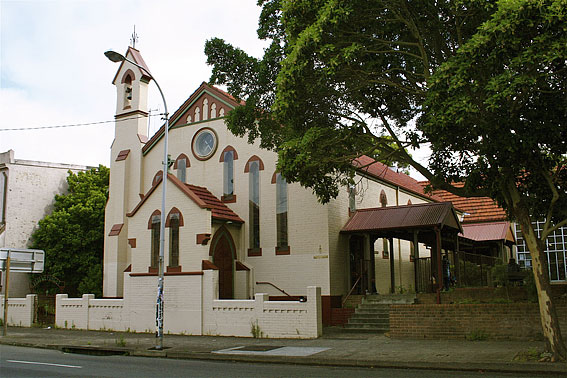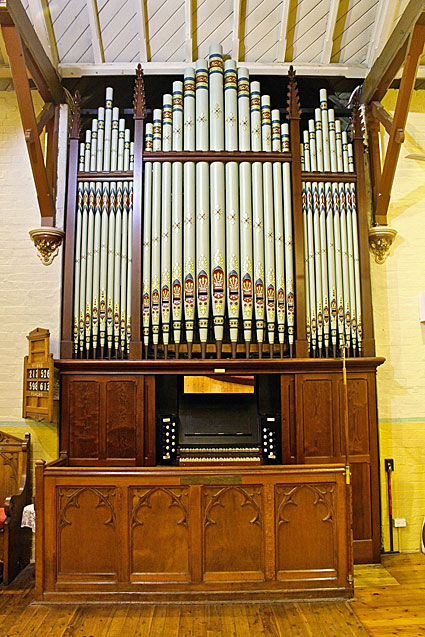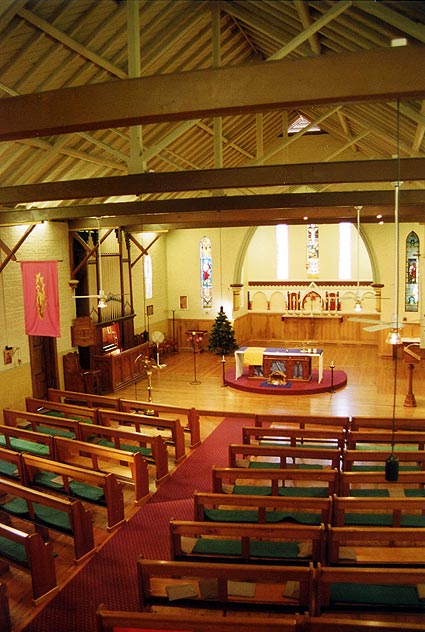St Luke's Anglican Church, Enmore
11 Stanmore Road, Enmore
Wordsworth and Maskell 1883, 2 manuals, 14 speaking stops, mechanical


Photos: Trevor Bunning (Oct 2018)
From SOJ Summer 2006-2007:
The organ was built by Wordsworth and Maskell in 1883. It is one of the few examples of the work of this English builder in Australia.
The Church
The Church of England Parish of Enmore was first dedicated as Christ Church, with the current dedication to St. Luke not until eighty years later in 1963.
The first registered church service was held on Sunday June 20, 1880 in a weatherboard building in Fotheringham Street. The laying of the foundation stone for the current building occurred on Saturday 4 March 1882 and the building opened on 18 June 1882.
The Organ
The organ at St Luke's Anglican Church Enmore is believed to be the only Australian example of an instrument built by Wordsworth & Maskell of Leeds UK.
The organ builders Wordsworth & Co. were originally known as Wordsworth & Maskell of Leeds. They built over 160 organs for the northern English counties and over fifty new organs in Leeds. They also exported instruments to India, Newfoundland, Russia, Australia, Canada and the West Indies.
Erection of the organ at Enmore began with its unpacking in the church on Monday 17 December 1883 and was completed on Saturday 22 December 1883. The formal opening took place on 1 January 1884.
The organ is mechanical action, of two manuals each of 56 keys and pedalboard of 30 keys. There are 13 stops. It is contained in a 'post and rail' case displaying pipes of the Open Diapason and Dulciana. Some of these pipes bear the inscription "W Hudson decorator. Leeds works England 1883. Wordsworth and Maskell Builder". The tops of the case posts are fitted with ornate pinnacles; the console has angled stop jambs; key cheeks are of a distinctive, scrolled profile and the bellows weights have the initials 'W&M' cast in.
Proposed Restoration
The church proposes to restore the organ and to replace some unoriginal pipework to bring it back to its original specification. The organ is essentially in original condition, having had very little work done to it since its installation. Some partial restoration work was carried out c.1975. At some time the Great Fifteenth was replaced by a tenor C compass Clarionet. Unfortunately the organ was vandalized in 1983 when quite a number of Clarionet pipes were removed or broken. The façade pipes were originally diapered but have been painted over at a later date. Some of the original diapering may still be seen. Currently the organ is used for Sunday services, choir practice, and occasional recitals. Having a reliable heritage organ will ensure the continuation of its presence in the church and wider community.
Stage One of the restoration will render the organ more reliable and include:
- Restoration of the Great and Swell soundboards
- Pipes to be repaired, missing pipes replaced
- A 2' Fifteenth to replace the existing unoriginal and vandalised Clarionet stop
- Action to be cleaned and re-set
Stage Two of the restoration will include:
- Rediapering of the façade pipes
- Front case panels, framework and impost stripped and repolished
- Drawstop jambs stripped and repolished
From SOJ Spring 2013, Peter Jewkes reports:
This splendid Wordsworth & Maskell organ, restored by the Jewkes firm in 2011, was of course originally hand-blown from within the organ chamber. A noisy external electric blower was added in the earlier 20th century, and replaced in 1994 by an English blower donated to the church by St Mary's Waverley, when their own instrument was re-constructed by the Jewkes firm. Though having given good service to 2 different instruments since c.1962, this blower's motor had been re-wound badly at some stage, and its slightly exposed position near the console at Enmore resulted in distractingly noisy operation, so it had been intended for some time to replace it with a brand new machine. As funds were not avaiable for this work at the time of the organ's restoration, the old blower remained in situ, but thanks to the enthusiasm and efforts of the parish organists, clergy and others, a new silent German blower has been installed. In a serendipitous moment shortly after the blower's connection, the Rector entered the church and asked if he might hear it turned on, to which the amused Jewkes staff were able to inform him that in fact it was turned on!

St Luke's Anglican Church, Enmore, NSW
Historical and Technical Documentation by Kelvin Hastie
© OHTA (last updated June 2011)
The below material first published in OHTA News April 2011
St Luke's Anglican Church, in the inner-city Sydney suburb of Enmore, is home to the only organ in Australia confirmed as being built by the Leeds partnership of Wordsworth & Maskell. The church – formerly known as Christ Church – acquired the instrument in 1883 and Rushworth records that it was installed by the Layton Bros, of Newtown, in the short time of six days. It was opened on New Year's Day, 1884.1
In 1981 John Stiller documented the organ on behalf of OHTA. His statement of historic significance and comparative importance was as follows:
This organ is a unique example in Australia of a small nineteenth-century organbuilding firm. Its tonal design indicates a pronounced late-Romantic tendency, and the instrument is in a remarkably good state of preservation. The following characteristics are noteworthy:
- Apart from the pipework which has recently been stolen, most of the original pipework remains, and the open metal pipes retain their cone tuning.
- The original case has been preserved, apart from the removal of the display pipe decorations.
- The original console is still present, and contains nineteenth-century fittings such as stopknobs, stop labels, keyboards, keyboard cheeks, composition pedals, nameplate of builder and Swell-shutter control. [Also of interest is the fact that the original pedal was noted in the Sydney Morning Herald of 11 December 1883 as being of radiating design, an advanced feature for the period].
- The original double-rise bellows has been retained, and is weighted with the only examples of Wordsworth & Maskell bellows weights in this country.
- The original mechanical key, stop and combination actions have been retained.2
Specification
Great
- 8' Open Diapason
- 8' Stop'd Diapason
- 8' Dulciana
- 8' Gamba
- 4' Principal
- 4' Harmonic Flute
- II Mixture 12.15
Swell
- 8' Open Diapason
- 8' Lieblich Gedact
- 8' Keraulophon
- 4' Principal
- 2' Harmonic Piccolo
- 8' Hautbois
- Tremulant
Pedal
- 16' Bourdon
Couplers
- Swell to Great
- Swell to Pedal
- Great to Pedal
Compass: 56/30
Mechanical key and stop action
3 composition pedals each to Great and Swell